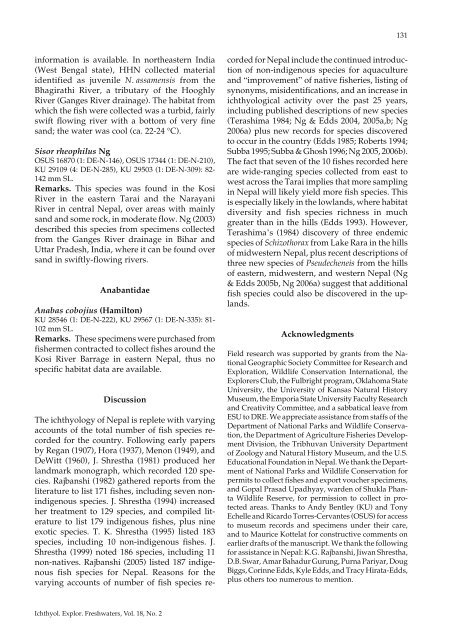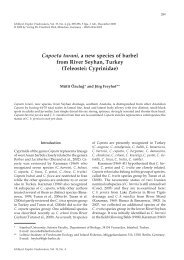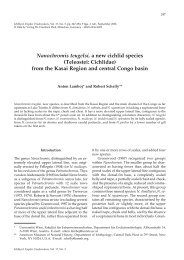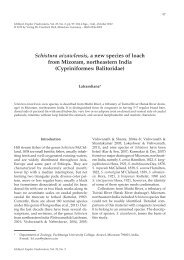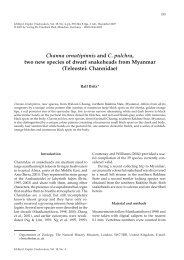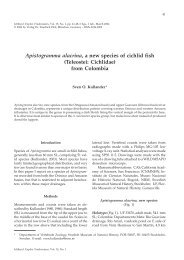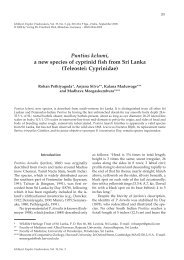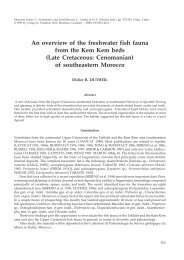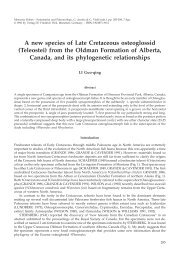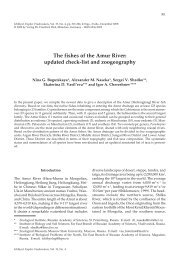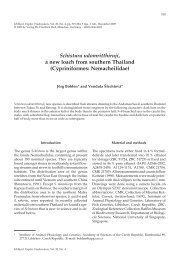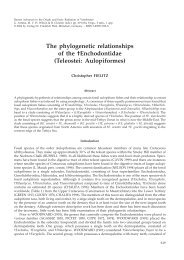Additions to the ichthyofauna of Nepal, with a redescription of ...
Additions to the ichthyofauna of Nepal, with a redescription of ...
Additions to the ichthyofauna of Nepal, with a redescription of ...
Create successful ePaper yourself
Turn your PDF publications into a flip-book with our unique Google optimized e-Paper software.
131<br />
information is available. In nor<strong>the</strong>astern India<br />
(West Bengal state), HHN collected material<br />
identified as juvenile N. assamensis from <strong>the</strong><br />
Bhagirathi River, a tributary <strong>of</strong> <strong>the</strong> Hooghly<br />
River (Ganges River drainage). The habitat from<br />
which <strong>the</strong> fish were collected was a turbid, fairly<br />
swift flowing river <strong>with</strong> a bot<strong>to</strong>m <strong>of</strong> very fine<br />
sand; <strong>the</strong> water was cool (ca. 22-24 °C).<br />
Sisor rheophilus Ng<br />
OSUS 16870 (1: DE-N-146), OSUS 17344 (1: DE-N-210),<br />
KU 29109 (4: DE-N-285), KU 29503 (1: DE-N-309): 82-<br />
142 mm SL.<br />
Remarks. This species was found in <strong>the</strong> Kosi<br />
River in <strong>the</strong> eastern Tarai and <strong>the</strong> Narayani<br />
River in central <strong>Nepal</strong>, over areas <strong>with</strong> mainly<br />
sand and some rock, in moderate flow. Ng (2003)<br />
described this species from specimens collected<br />
from <strong>the</strong> Ganges River drainage in Bihar and<br />
Uttar Pradesh, India, where it can be found over<br />
sand in swiftly-flowing rivers.<br />
Anabantidae<br />
Anabas cobojius (Hamil<strong>to</strong>n)<br />
KU 28546 (1: DE-N-222), KU 29567 (1: DE-N-335): 81-<br />
102 mm SL.<br />
Remarks. These specimens were purchased from<br />
fishermen contracted <strong>to</strong> collect fishes around <strong>the</strong><br />
Kosi River Barrage in eastern <strong>Nepal</strong>, thus no<br />
specific habitat data are available.<br />
Discussion<br />
The ichthyology <strong>of</strong> <strong>Nepal</strong> is replete <strong>with</strong> varying<br />
accounts <strong>of</strong> <strong>the</strong> <strong>to</strong>tal number <strong>of</strong> fish species recorded<br />
for <strong>the</strong> country. Following early papers<br />
by Regan (1907), Hora (1937), Menon (1949), and<br />
DeWitt (1960), J. Shrestha (1981) produced her<br />
landmark monograph, which recorded 120 species.<br />
Rajbanshi (1982) ga<strong>the</strong>red reports from <strong>the</strong><br />
literature <strong>to</strong> list 171 fishes, including seven nonindigenous<br />
species. J. Shrestha (1994) increased<br />
her treatment <strong>to</strong> 129 species, and compiled literature<br />
<strong>to</strong> list 179 indigenous fishes, plus nine<br />
exotic species. T. K. Shrestha (1995) listed 183<br />
species, including 10 non-indigenous fishes. J.<br />
Shrestha (1999) noted 186 species, including 11<br />
non-natives. Rajbanshi (2005) listed 187 indigenous<br />
fish species for <strong>Nepal</strong>. Reasons for <strong>the</strong><br />
varying accounts <strong>of</strong> number <strong>of</strong> fish species recorded<br />
for <strong>Nepal</strong> include <strong>the</strong> continued introduction<br />
<strong>of</strong> non-indigenous species for aquaculture<br />
and “improvement” <strong>of</strong> native fisheries, listing <strong>of</strong><br />
synonyms, misidentifications, and an increase in<br />
ichthyological activity over <strong>the</strong> past 25 years,<br />
including published descriptions <strong>of</strong> new species<br />
(Terashima 1984; Ng & Edds 2004, 2005a,b; Ng<br />
2006a) plus new records for species discovered<br />
<strong>to</strong> occur in <strong>the</strong> country (Edds 1985; Roberts 1994;<br />
Subba 1995; Subba & Ghosh 1996; Ng 2005, 2006b).<br />
The fact that seven <strong>of</strong> <strong>the</strong> 10 fishes recorded here<br />
are wide-ranging species collected from east <strong>to</strong><br />
west across <strong>the</strong> Tarai implies that more sampling<br />
in <strong>Nepal</strong> will likely yield more fish species. This<br />
is especially likely in <strong>the</strong> lowlands, where habitat<br />
diversity and fish species richness in much<br />
greater than in <strong>the</strong> hills (Edds 1993). However,<br />
Terashima’s (1984) discovery <strong>of</strong> three endemic<br />
species <strong>of</strong> Schizothorax from Lake Rara in <strong>the</strong> hills<br />
<strong>of</strong> midwestern <strong>Nepal</strong>, plus recent descriptions <strong>of</strong><br />
three new species <strong>of</strong> Pseudecheneis from <strong>the</strong> hills<br />
<strong>of</strong> eastern, midwestern, and western <strong>Nepal</strong> (Ng<br />
& Edds 2005b, Ng 2006a) suggest that additional<br />
fish species could also be discovered in <strong>the</strong> uplands.<br />
Acknowledgments<br />
Field research was supported by grants from <strong>the</strong> National<br />
Geographic Society Committee for Research and<br />
Exploration, Wildlife Conservation International, <strong>the</strong><br />
Explorers Club, <strong>the</strong> Fulbright program, Oklahoma State<br />
University, <strong>the</strong> University <strong>of</strong> Kansas Natural His<strong>to</strong>ry<br />
Museum, <strong>the</strong> Emporia State University Faculty Research<br />
and Creativity Committee, and a sabbatical leave from<br />
ESU <strong>to</strong> DRE. We appreciate assistance from staffs <strong>of</strong> <strong>the</strong><br />
Department <strong>of</strong> National Parks and Wildlife Conservation,<br />
<strong>the</strong> Department <strong>of</strong> Agriculture Fisheries Development<br />
Division, <strong>the</strong> Tribhuvan University Department<br />
<strong>of</strong> Zoology and Natural His<strong>to</strong>ry Museum, and <strong>the</strong> U.S.<br />
Educational Foundation in <strong>Nepal</strong>. We thank <strong>the</strong> Department<br />
<strong>of</strong> National Parks and Wildlife Conservation for<br />
permits <strong>to</strong> collect fishes and export voucher specimens,<br />
and Gopal Prasad Upadhyay, warden <strong>of</strong> Shukla Phanta<br />
Wildlife Reserve, for permission <strong>to</strong> collect in protected<br />
areas. Thanks <strong>to</strong> Andy Bentley (KU) and Tony<br />
Echelle and Ricardo Torres-Cervantes (OSUS) for access<br />
<strong>to</strong> museum records and specimens under <strong>the</strong>ir care,<br />
and <strong>to</strong> Maurice Kottelat for constructive comments on<br />
earlier drafts <strong>of</strong> <strong>the</strong> manuscript. We thank <strong>the</strong> following<br />
for assistance in <strong>Nepal</strong>: K.G. Rajbanshi, Jiwan Shrestha,<br />
D.B. Swar, Amar Bahadur Gurung, Purna Pariyar, Doug<br />
Biggs, Corinne Edds, Kyle Edds, and Tracy Hirata-Edds,<br />
plus o<strong>the</strong>rs <strong>to</strong>o numerous <strong>to</strong> mention.<br />
Ichthyol. Explor. Freshwaters, Vol. 18, No. 2


